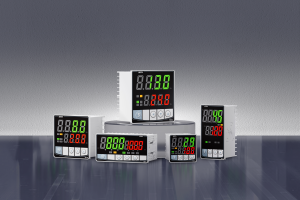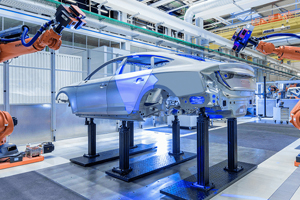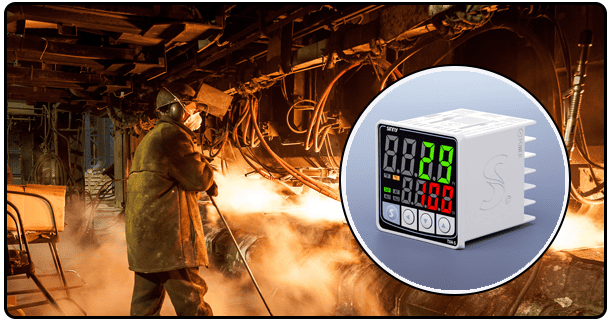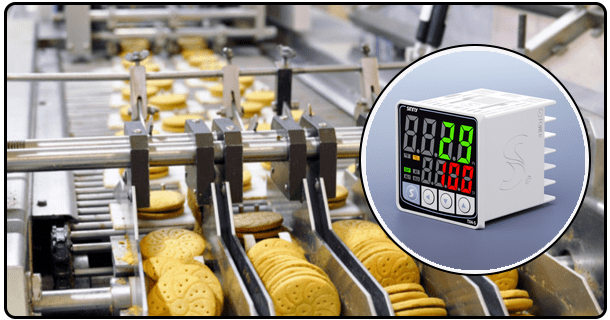PID temperature controllers with profiles: mastering temperatures profiles for complex processes
1. Temperature Profiling
The need for Beyond Setpoint ControlTemperature regulation plays a key role in countless commercial, industrial and scientific processes. Maintaining specific temperatures is important in many areas, from the comfort of your home to microelectronics or advanced materials science. The basic temperature control systems that rely on on/off switches or PID loops with a simple point of setpoint serve many functions. They fall short, however, when the process requires a sophisticated thermal journey. The concept of temperature profile becomes crucial in this situation. The process of temperature profiling is to execute a series of temperatures that are each held for a certain duration in order to reach a particular outcome. A Profile PID temperature controller is required to implement this complex sequence accurately and reliably. They take PID principles and add the ability to manage and store multi-stage temperatures profiles. Profile PID controllers are primarily focused on their capability to manage complex thermal cycles. This ensures precision and consistency at each stage and enables superior product performance.
2. Understand Temperature Profile: What Is it? Why is It Important?
In order to define temperature profiling, it's important to understand that the goal isn't just to reach and maintain a certain temperature. It involves carefully planning a sequence of stages, which is often referred to as a "profile". In each stage, the heating or cooling process is typically held at a certain temperature for a specified duration and then moved to the next. In polymer extrusion for example, the profile may involve heating the material to melt it, then holding the temperature at that level to maintain uniformity. Finally, cooling is used to obtain the final desired properties. Profiles for metal heat treatments may include austenitizing stages, quenching and tempering. Each stage requires precise temperature and time control. This method of controlling is so important. Answer lies in many of the advanced processes. The ability to meet specific profile requirements can ensure product consistency and prevent defects. It also optimizes the reaction conditions and reduces cycle time compared with simpler methods. Standard control strategies are unable to achieve accurate and stable controls throughout the multi-stage sequences. This is why Profile PID controllers provide an ideal solution.
3. How PID Control is Used to Regulate Profile Temperature
In order to fully understand the profile PID controller's capabilities, it is helpful to review the PID algorithm. PID, standing for Proportional-Integral-Derivative, is a widely used control loop feedback mechanism. The error value is calculated as the difference between the target temperature (that was set for the specific stage in the process) and what actually happened (the actual temperature). The error value is processed by three different components.
Control (P) Proportional: The component produces an output signal directly proportional the error. The output signal becomes stronger as the error increases. However, pure proportional control can lead to steady-state errors, which means the system may not achieve the setpoint exactly.
Integral Control (I): Over time, the integral component accumulates errors. The integral term increases if the error continues, which causes the output to rise further and drive the system toward the setpoint. It can help eliminate steady-state errors, but it may introduce lag or cause an overshoot when not properly tuned.
Control (D) Derivative: This component uses the error rate to predict future errors. The output is opposite to the rate of change. This helps to reduce oscillations, prevent overshoot and contributes to a more stable and faster response.
PID's fundamental function in profile control involves continuously adjusting the output signal (e.g. controlling a cooler or heater) according to the actual deviation of the setpoint for the stage. It is important that the controller can execute the sequence stored, while the PID loops within it are responsible for ensuring the temperature follows the path desired - warming up, stabilizing, cooling down. The primary objective of PID profile control is to achieve consistency and repetition across all stages. This often requires tight tolerances. It is not enough to have a PID algorithm, but you also need the intelligence necessary to control the sequence.
4. Determining PID Profiles: Sequential temperature stages
The core feature of a Profile PID Temperature Control is its ability to save and execute complex temperatures profiles. A profile PID temperature controller is different from a standard PID set at a single value. It has features that are specifically tailored to manage multi-stage thermal cycle. These controllers typically have the following features:
Storage and management of profiles: Ability to store one or more temperature profiles in the memory of the controller (often not volatile, so they remain even after power removal). The user can easily choose and execute established processes. This interface should make it easy to view and edit these profiles.
Sequential execution logic: A controller must be able to automatically initiate, monitor and advance through each profile stage. It is necessary to use logic that will move the profile from one level (e.g. temperature setpoints and durations) to another upon completion of a stage or on the basis of time. Visual monitoring is often possible with user-friendly interfaces. They show the stage, temperature setpoint, current temperature and deviation.
Implementation of Multi-Stage Profile Control: The control profile can be implemented in a variety of ways. Certain controllers may use several internal PID loops - one for each of the stage parameters. Some controllers may use a PID algorithm in combination with complex logic to manage the dynamic transitions from one temperature profile to another. The controller should allow the tuning of the PID (Kp Ki Kd) parameters for each stage (e.g. fast heating, steady hold, gentle cooling).
Editing and Modification of Profiles: The user should have the ability to create or edit existing profiles. It is best to use a graphic interface that shows the temperature over time and allows for dragging points or typing in parameters. The process can be optimized significantly with this feature.
Stage Transitions with Precision: A controller is required to manage stage transitions smoothly and precisely. It may be necessary to ramp up the temperature until it reaches the setpoint for the next stage and then stabilize the temperature before starting the hold time. For process integrity, it is important to ensure that stage transitions occur accurately.
Advanced features (Optional Features): Certain controllers have enhanced capabilities such as auto-tuning of the PID parameter within each stage and adaptive control algorithms which adjust parameters according to process changes. They also offer advanced monitoring capabilities and integration with data log systems.
A Profile PID Controller adds Sequence Management to the standard PID. The basic PID controller is combined with the capability to create a path that can be predefined or generated dynamically.
5. The Benefits of Profile PID Controls
Profile PID offers several advantages over other control methods. This is especially true for applications that require precise thermal control in multiple stages. These benefits directly contribute to improving process performance and quality.
Simplicified Operation and Implementation: The profile is stored in the controller, which simplifies the setup. The technology is more accessible because users do not have to perform complex programming externally or manually during the execution.
Improved Process Consistency : The Profile PID Controller ensures the process is consistent by executing it precisely. The result is highly uniformed products with reduced variability, and improved quality control.
Reproducibility Improved: A consistent profile execution allows the process to be replicated reliably run after run. It is important for regulatory compliance, quality assurance (e.g. GMP standards in pharmaceuticals), and predictable results.
Increased efficiency: The profile controllers can optimize heating and cooling. They can, for example, allow faster heating before a hold and precise temperature control, as well as optimized cooling schedules. This will lead to shorter cycle times than basic methods.
Safety Features: Controlling profiles often requires managing critical processes. Commonly, controllers include safety features such as alarms when a deviation occurs (e.g. temperature exceeds limits or stage completion). They also provide notifications of stage completion and, if necessary, safety interlocks to stop the process in case deviations happen. It improves the operational safety.
Ease and Accessibility: Many profile controllers have been designed to be user-friendly, allowing users of varying technical proficiency levels the opportunity to perform sophisticated thermal profiling.
Profile PID Controllers offer many advantages that make them the preferred solution when multi-stage temperatures are required.
6. Uses where Profile PID control is essential
In industries that require thermal management, the need to control profiles precisely is common. Profiles are often required for complex chemical reactions, materials transformations or heating/cooking processes, where simply reaching the target temperature is not enough. Applications include:
Manufacturing Industry: Controlling temperature is essential in industries such as polymer extrusion, metal treatment, paint curing, plastic molding, where precise temperature control and transitions between temperatures are required.
Food processing: Specific methods of cooking often require precise stages such as She Ding cooking curves. The Profile PID Controllers provide consistent results in processes such as baking, pasteurization and beverage processing.
Scientific Research and Development Many lab processes require precise and repeatable thermal profiles. These include material synthesis and chemical reactions that need specific temperatures, as well as incubation chambers and environmental chambers.
Educational and Small Business Settings: Equipment that requires pre-programmed profiles to ensure consistency and reproducibility is a great benefit in both educational and small business settings. Examples of this include drying equipment or models that demonstrate complex thermal processes.
Profile PID controllers are indispensable for these applications because they allow the exact execution of thermal sequences with multiple stages.
7. How to Select the Best Profile PID Controller
When choosing the right Profile PID Controller, it is important to carefully consider your application's requirements as well as its technical specs. All controllers are not created equal. It is important to choose the correct controller in order to achieve the performance and reliability you desire. The following are key factors to take into consideration:
Capacity of Profiles and complexity: A controller that is capable of handling the number of stages required, maximum duration, temperature range, sensor types (e.g. thermocouple or RTD), and accuracy with resolution required. Verify the specification for maximum stage counts, durations, and temperature ranges. Check that the sensor range and type you require is supported. Verify that the accuracy of the controller (often specified as +-degC, or % reading), meets your application tolerance requirements. Verify resolution of controller (i.e. display updates or control resolution).
Features for Editing and Creating Profiles: User-Friendliness is key. You should look for interfaces that are intuitive (graphical displays and simple programming logic). Take into account the ease with which profiles can be created, saved, modified, or loaded. The ability to edit profiles graphically can be extremely helpful. Check for stage parameters, safety features, and timing.
Stability and Accuracy: Like standard PID, stability and accuracy are important. These key parameters are specified in the specification. Consider resolution.
Performance PID: Verify the performance specifications (resolution, sample rate). Look for auto-tuning features for the profile stages.
Integration and Connectivity: Standard Outputs (analog or digital) to integrate withShangWei Ji equipment. Connectivity to the network (RS485, Ethernet) for remote monitoring and control. Look for Modbus, Ethernet/IP or DeviceNet.
User interface: Clear displays, easy navigation and parameter adjustments are essential. Features like menus and navigation, graphical displays are important. Check for features like parameter display, alarm indication.
Safety Features Look for alarms, safety limits and interlocks.
By carefully evaluating these factors, you can ensure that the controller selected meets your application requirements and has the features necessary for a successful implementation.
8. Installing, setting up, and creating profiles
For optimal performance, it is important to execute carefully during the installation process, configuration, and creation of profiles.
Considerations for Installation: Carefully follow the instructions provided by the manufacturer. Place the sensor correctly. Be sure to pay attention to the wiring and ensure that all connections are made correctly. Electrical noise or interference can affect the readings of sensors. Check that the power connection is stable and correct.
Configuring the Profile Controller: Turn on the controller. You should be guided through the initial configuration by the interface. The controller interface allows you to set the profile settings. Configure inputs, e.g. auto-detection of sensor types. Configure the output options. Configure alarms and safety limits.
Saving and Creating Profiles: Create the profile using the controller's interface. Define stages (temperatures and durations). Save the profile. Check that the configuration and accuracy of the sensors match the needs.
Start and Monitor Profile Execution Run the profiles. Monitor the display. Check the parameters of your profile.
Tuning Profile Stages. If required, the profile controller should allow for tuning of PID parameters at each stage. Different PID requirements at different stages.
Profile PID controllers, like any other sophisticated equipment require some basic maintenance and may present problems when troubleshooting.
idelity temperature control due to their easy-to-use user interfaces and robust performances.
- A Guide to the Schematic Diagram of PID Temperature Control
- Instantaneous precision control with Plug-and Play temperature controllers























